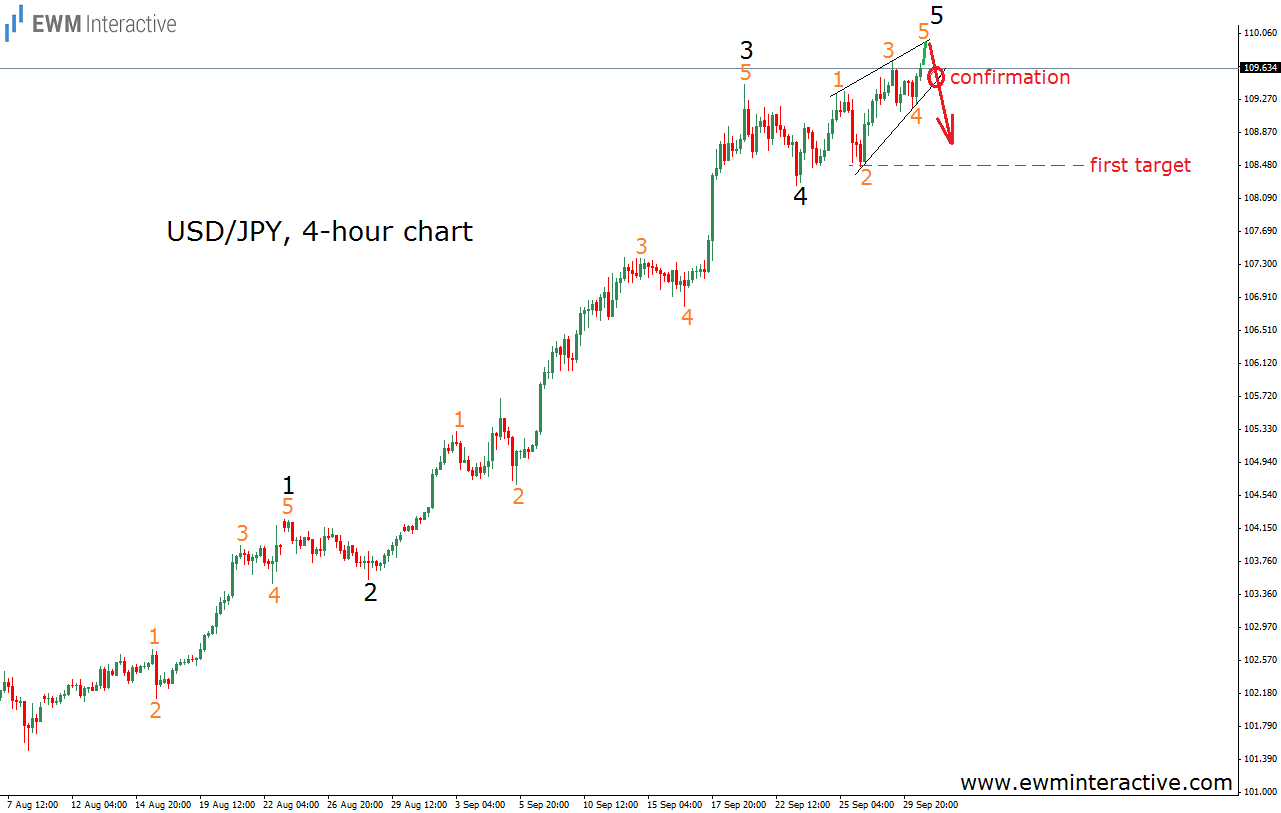USD JPY has been in a strong uptrend for the last two months. Is it time for the bulls to take a rest? Traders may want to see what the probabilities show.
Our job as analysts is to try to determine when the trend is most likely to reverse or make a pull-back. In order to do that, we use a method, called the Elliott Wave Principle. It is probably the most advanced price-pattern recognition technique. According to it, trends move in five-wave sequences, called impulses. Every impulse is followed by a correction in the opposite direction. So, in the case with USD JPY, we have to see, if there is a complete five-wave move. If there is one, we should prepare for a pull-back.
And the 4-hour chart shows a very clear impulsive rally, which seems to be approaching the end of its fifth wave. Fifths waves take the form of either a regular “five” or an ending diagonal. Judging from the wave structure, it looks more like the second possibility. Those of you, who have read our article about ending diagonals, probably know that this is a very tricky pattern. That is why there are three different approaches, when it comes to trading, depending on what type of trader you are. The more aggressive your style is, the earlier you pull the trigger – at the top of wave 5 of the diagonal. Conservative traders prefer to wait for the extreme of wave 4 to give away before initiating a trade. And the third choice is the one we fancy – to wait for the lower line of the diagonal to be broken. There is no right or wrong way to trade this pattern. It all depends on you personal risk tolerance and trading style.
If this is the correct count, USD JPY should make a new high above 109.74, but the 110.00 area may serve as a strong resistance and a reversal zone. The first target to the downside is around 108.50.
Trading financial instruments entails a great degree of uncertainty and a variety of risks. EMW Interactive’s materials and market analysis are provided for educational purposes only. As such, their main purpose is to illustrate how the Elliott Wave Principle can be applied to predict movements in the financial markets. As a perfectly accurate method for technical analysis does not exist, the Elliott Wave Principle is also not flawless. As a result, the company does not take any responsibility for the potential losses our end-user might incur. Simply, any decision to trade or invest, based on the information from this website, is at your own risk.
Recommended Content
Editors’ Picks
EUR/USD stays below 1.0700 after US data

EUR/USD stays in a consolidation phase below 1.0700 in the early American session on Wednesday. The data from the US showed a strong increase in Durable Goods Orders, supporting the USD and making it difficult for the pair to gain traction.
USD/JPY refreshes 34-year high, attacks 155.00 as intervention risks loom

USD/JPY is renewing a multi-decade high, closing in on 155.00. Traders turn cautious on heightened risks of Japan's FX intervention. Broad US Dollar rebound aids the upside in the major. US Durable Goods data are next on tap.
Gold trades on the back foot, manages to hold above $2,300

Gold struggles to stage a rebound midweek following Monday's sharp decline but manages to hold above $2,300. The benchmark 10-year US Treasury bond yield stays in the green above 4.6% after US data, not allowing the pair to reverse its direction.
Worldcoin looks set for comeback despite Nvidia’s 22% crash Premium

Worldcoin price is in a better position than last week's and shows signs of a potential comeback. This development occurs amid the sharp decline in the valuation of the popular GPU manufacturer Nvidia.
Three fundamentals for the week: US GDP, BoJ and the Fed's favorite inflation gauge stand out Premium

While it is hard to predict when geopolitical news erupts, the level of tension is lower – allowing for key data to have its say. This week's US figures are set to shape the Federal Reserve's decision next week – and the Bank of Japan may struggle to halt the Yen's deterioration.
